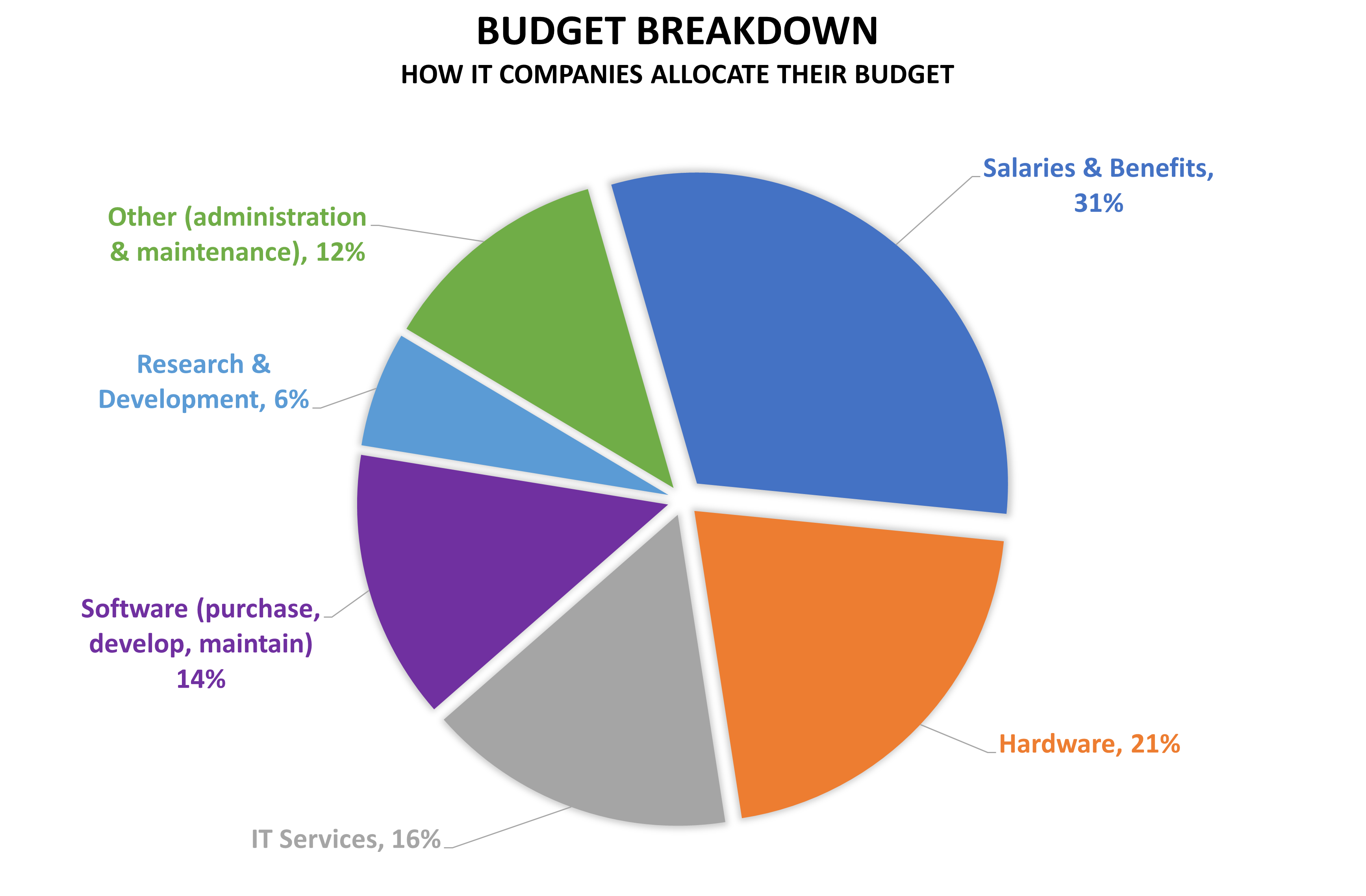Balancing tech innovation and budget constraints: A CTO’s guide to maximizing ROI.

Introduction
In the rapidly evolving technological landscape, the role of a CTO is more vital – and more challenging – than ever before. The exponential growth of emerging technologies such as AI, machine learning, cloud computing, and blockchain, among others, has created a pressing need for companies to stay at the forefront of innovation. However, as every tech leader knows, this pursuit of innovation is a delicate balancing act. On one hand, there’s the drive to explore new technologies and strategies to remain competitive. On the other, there are the ever-present constraints of budget and resources.
How does one strike the right balance? That’s the million-dollar question I’ll attempt to answer in this guide.
Defining ROI in the Context of Tech Innovation
Return on Investment (ROI) is a critical metric in any business context, and technology is no exception. However, quantifying the ROI of technology can be a complex task. In addition to the direct financial returns, tech investments often yield indirect benefits like improved efficiency, enhanced customer experience, or stronger data security. Therefore, a comprehensive assessment of tech ROI should consider both these tangible and intangible returns.
For our discussion, I’ll define ROI as the total value (both financial and non-financial) that an organization derives from its tech investments, relative to the cost of those investments. In other words, it’s not just about saving money or increasing revenue; it’s about maximizing the overall business value.
As I navigate through this guide, I’ll delve into the complexities of the tech-budget conundrum, explore practical strategies for maximizing ROI, and learn from real-world examples of companies that have successfully struck the balance. I hope that by the end of this journey, you’ll have a roadmap to guide your own tech strategy.
Understanding the Challenge
As a CTO in a small or medium-sized company, you’re likely all too familiar with the challenges of managing a tech budget. According to a survey by Spiceworks, IT budgets for small and medium businesses were expected to grow by a modest 2% on average in 2023, with the majority of the budget allocated to hardware purchases, followed by software, cloud, and managed IT services.
Yet, despite these modest growth projections, the pressure to innovate remains high. Businesses are expected to do more with less, and technology often becomes the conduit to achieve this.

The Pressure to Innovate
The Silicon Valley narrative has, in many ways, defined the modern tech startup ecosystem. The story of a small startup disrupting an entire industry with innovative technology is now a well-worn trope. And while it’s true that such disruption can lead to massive success, it also sets a high bar for other startups and small businesses. The expectation to innovate — and quickly — can create a tension between the desire to build cutting-edge technology and the need to manage a limited budget.
Case Study: Intuit Mailchimp – Balancing Innovation and Costs
Mailchimp, an all-in-one Marketing Platform for small businesses, provides a compelling example of how companies can balance innovation with budget constraints. The company started in 2001 as a side project for the co-founders Ben Chestnut and Dan Kurzius. Initially, they offered a paid product, but soon found that their growth was slower than they’d hoped.
In 2009, they made a bold move. Mailchimp introduced a freemium model, which allowed users to use their service for free up to a certain number of subscribers. This was a significant innovation in the email marketing space, and it was a risk, as it could potentially drain their resources.
However, they had a strategy behind this move. They believed that by offering high-quality services for free, they could attract a large user base. They could then monetize the user base by offering premium features and services.
To mitigate the cost of supporting a freemium model, Mailchimp made significant investments in automation and efficiency. They developed an AI assistant, “Omnivore,” which helped them monitor and manage their user base effectively, thus reducing the need for a large support team.
The gamble paid off. The freemium model attracted a large number of small businesses, many of whom later upgraded to paid plans as their businesses grew. Today, Mailchimp is a highly successful company, with millions of users and over $800 million in annual revenue.
The Mailchimp story shows how innovation isn’t always about using the latest technology, but about finding new and creative ways to deliver value to customers while managing costs effectively.
Aligning Business and Tech Goals
Successful technology management requires a deep understanding of both the technical and business sides of an organization. For a CTO, this means not only understanding the latest technologies but also appreciating how these technologies can drive business value.
Bridging the Communication Gap
A common challenge in many organizations is the communication gap that exists between the tech team and the rest of the business. As a tech leader, one of your key roles is to bridge this gap. This involves translating technical jargon into business language that stakeholders can understand and appreciate. Simultaneously, it also means interpreting business needs and translating them into technical requirements for your team.
Case Study: Spotify – Aligning Tech Goals with Business Goals
Spotify, the popular music streaming service, offers an excellent example of aligning tech and business goals. When Spotify expanded into new markets, they faced a challenge: how to deliver a seamless music streaming experience to a rapidly growing global user base, all while managing costs.
As the CTO, Oskar Stål had a critical role in managing this challenge. One key decision was to invest in a hybrid cloud strategy. Spotify moved the bulk of their services to Google Cloud Platform (GCP), leveraging the scalable infrastructure that Google provided to handle their growing user base. But they also retained some key data processes in-house, using their own data centers.
This strategic decision required a deep understanding of both the technical and business needs of the company. From a tech perspective, it allowed Spotify to leverage GCP’s superior data analytics and machine learning capabilities, which was essential for improving their recommendation algorithms. From a business perspective, this move helped manage costs by reducing the need for managing and maintaining large data centers, while still retaining control over key data processes.
Another key role Stål played was in effectively communicating this tech strategy to the rest of the business. He explained how this move would not only save costs but also enhance the company’s core capabilities, thus helping Spotify deliver a better user experience and drive growth.
The Spotify story illustrates how a tech leader can align tech and business goals, and effectively communicate this alignment to the rest of the business.
Strategies for Maximizing ROI
Given the pressure to innovate and the constraints of a limited budget, it’s essential to have a clear strategy in place to maximize the return on your tech investments. Here are four key strategies that can help:
1. Adopting Agile and Lean Practices
Agile and Lean methodologies can help your team deliver value faster, improve quality, and reduce waste. The emphasis on iterative development, continuous feedback, and process improvement can help you optimize resources and increase efficiency. For example, through the use of sprints and a backlog in Agile, you can prioritize tasks that deliver the most value and quickly adapt to changes.
2. Investing in Open-Source Technologies
Open-source technologies can provide an avenue for companies to leverage cutting-edge technology without the high costs typically associated with proprietary software. Open source is not just about cost savings; it’s also about freedom and flexibility.
You have the freedom to use and customize the software as per your requirements without being tied down by restrictive licenses.
The beauty of the open-source landscape is that it spans across virtually all categories of technology, providing viable alternatives to their proprietary counterparts. Key areas where you need to consider an open-source alternative can be a database technology, server technology, CRM software, Content Management system, and an e-Commerce Platform.
3. Leveraging Cloud Services
Similar to the Spotify case we discussed earlier, cloud services can offer scalable, pay-as-you-go solutions that can help manage costs. By leveraging cloud services, you can avoid the high upfront costs of setting up and maintaining physical servers, and only pay for the resources you actually use.
4. Fostering Internal Talent vs Outsourcing
Having every expertise in-house is not always feasible or cost-effective. This is where strategic outsourcing comes into play, especially when it’s done right, considering not only the technical aspects but also the team’s dynamics, culture, and values.
Consider, for example, the approach of TechCells, a company specializing in tailored IT outsourcing and outstaffing solutions. Unlike the conventional outsourcing model, TechCells places a significant emphasis on ensuring an incredible synergy between the in-house and outsourced talents. They do this by not only matching the technical skills required but also considering other critical factors like cultural fit, team dynamics, and communication styles.
This comprehensive approach ensures that the outsourced team members work effectively with the in-house team, driving better results and minimizing potential friction or misunderstandings. In essence, TechCells’ model provides you with an extended team, which can be scaled up or down based on your changing business needs.
As a CTO, your goal is not to choose between internal development and outsourcing, but rather to find the right balance between the two. When done right, talent outsourcing can save you between 40% and 60% in engineering payroll.
ROI Metrics: Measuring Success
Technology investments, like any business endeavor, need to be evaluated based on their returns. However, measuring the return on investment (ROI) in technology can be complex due to the multifaceted nature of tech impacts on business. Here, we’ll explore traditional ROI calculation and its limitations, introduce the balanced scorecard approach, and illustrate these concepts with a case study of Etsy.
Traditional ROI Calculation: Strengths and Limitations
The traditional ROI calculation is straightforward: the gain from the investment minus the cost of the investment, divided by the cost of the investment. Expressed as a percentage, a positive ROI indicates that the investment has generated more value than it cost.
However, when it comes to technology investments, this formula can oversimplify the picture. Tech investments often yield intangible benefits like increased employee productivity, enhanced customer satisfaction, or improved data security. These benefits are real and valuable but difficult to quantify in monetary terms.
The Balanced Scorecard Approach
To address the limitations of traditional ROI calculation, many companies turn to the Balanced Scorecard approach. This framework evaluates tech investments from four perspectives:

1. Financial: This mirrors the traditional ROI calculation, focusing on tangible financial benefits like increased revenue or reduced costs.
2. Customer: This evaluates how the tech investment has improved customer satisfaction, retention, or acquisition.
3. Internal Process: This measures improvements in efficiency, productivity, or quality resulting from the tech investment.
4. Learning and Growth: This assesses how the tech investment has contributed to employee development, organizational learning, or innovation.
By considering these multiple dimensions, the Balanced Scorecard approach provides a more comprehensive view of the ROI of tech investments.
Case Study: Etsy – Measuring ROI of Tech Innovation
Etsy, the renowned e-commerce platform for handmade and vintage goods, presents an instructive case of measuring ROI on tech innovation. Recognizing the need for agility in the rapidly evolving digital marketplace, Etsy made a significant investment to create an innovative continuous deployment system. This innovative approach allowed them to deploy code updates up to 50 times a day, vastly outpacing traditional deployment schedules and fostering a culture of rapid innovation and responsiveness.
To understand the return on this substantial investment, Etsy turned to the Balanced Scorecard approach, examining the impact of the continuous deployment system from multiple angles:
From a Financial perspective, the continuous deployment system reduced the cost of failures. Smaller, more frequent changes meant that issues could be detected and rectified quickly, minimizing their impact on the business and reducing associated costs.
In terms of Customer metrics, the system allowed Etsy to respond more quickly to customer feedback and needs. New features and improvements could be rolled out faster, enhancing the customer experience, and contributing to improved satisfaction and retention.
From an Internal Process standpoint, the system significantly boosted productivity. Developers spent less time dealing with large, cumbersome updates and more time focusing on value-adding activities, improving overall operational efficiency.
Finally, the Learning and Growth benefits were substantial. The new deployment system encouraged a culture of experimentation and learning, with developers receiving immediate feedback on their work. This environment not only nurtured their skills but also fostered a continuous improvement and innovation ethos within the organization.
Navigating The Risks
Risk is an inherent part of innovation. However, it can be managed effectively with the right strategies.
Risk Management Strategies for Tech Innovation
Here are a few strategies to consider:
1. Incremental Innovation: Instead of betting everything on a single, groundbreaking innovation, consider smaller, incremental innovations. This approach not only reduces risk but also allows for faster feedback and iterative improvements.
2. Prototyping and Testing: Before committing significant resources to a new tech project, build a prototype and test it extensively. This can help identify potential issues and mitigate risks early on. Sometime this generates tech debt, which I will talk abound in a moment.
3. Diversification: Don’t put all your eggs in one basket. Spread your tech investments across different projects, technologies, and areas of your business. If one investment doesn’t pan out, others might.
4. Continuous Learning: Foster a culture of learning from both successes and failures. Every tech project provides valuable lessons that can inform future decisions and reduce risks.
Handling Tech Debt
Tech debt refers to the implied cost of additional rework caused by choosing a quick and easy solution now instead of using a better approach that would take longer. It’s a common challenge for businesses striving to innovate quickly within tight budget constraints.
Here are a few strategies to manage tech debt effectively:
1. Strategic Accumulation: Not all tech debt is bad. Sometimes, accumulating tech debt is a strategic decision to speed up time-to-market or meet a critical business need. The key is to make these decisions consciously, understanding the trade-offs involved.
2. Regular Refactoring: Have your Engineering Manager accountable to create an engineering culture, where developers make it a habit to regularly revisit and improve the codebase. This continuous refactoring can help keep tech debt in check.
3. Debt Quotas: Establish a tech debt quota that sets a limit on how much tech debt your team can accumulate. Once the quota is reached, the focus shifts to repaying the tech debt before taking on new projects.
4. Documentation and Communication: Make sure the engineering team keeps clear records of where and why they’re accumulating tech debt. Ensure this information is communicated across the team, so everyone understands the implications and can plan accordingly.
While the risk is a real challenge, it doesn’t have to hinder tech innovation. With the right strategies, you can manage these challenges effectively, striking a balance that allows for sustainable, value-creating tech innovation.
Conclusion
As we have traversed the landscape of balancing tech innovation and budget constraints, it’s clear that this is not a journey of absolutes, but rather one of strategic balance and informed decision-making. Walking this tightrope is both an art and a science. It requires deep understanding of your organization’s unique context, a clear vision for the future, and the agility to adapt along the way.
The Path Forward: A Strategic Balance
Moving forward, the challenge for CTOs and engineering managers is to strike a strategic balance between investing in tech innovation and managing budget constraints. This balance isn’t static but needs to be constantly recalibrated in response to changing business needs, market dynamics, and technological advancements.
The framework and strategies discussed in this article provide a roadmap for this journey. They offer a structured approach to aligning tech and business goals, making strategic tech investment decisions, managing risks, and measuring success.
Remember, the goal isn’t to avoid risks or cut costs at all costs. Rather, it’s to understand and manage these aspects effectively, so they become enablers of innovation, not barriers.
Key Takeaways
To wrap up, here are the key takeaways from our discussion:
Align Tech and Business Goals: Start with a clear understanding of your business goals and align your tech strategy accordingly. Use tech as a lever to drive business value, not just as a cost center.
Leverage Existing Resources: Maximize the value of existing resources, be it in-house talent, outsourced expertise like TechCells, or open-source technologies.
Manage Risks and Tech Debt: Approach risk management and tech debt strategically. Incorporate them into your decision-making process and use them as tools for informed decision-making.
Measure Success Holistically: Go beyond traditional ROI calculation to measure the success of your tech investments. Consider a balanced scorecard approach that takes into account financial, customer, internal process, and learning and growth perspectives.
Iterate and Adapt: Be prepared to iterate and adapt your approach in response to feedback, learning, and changes in your business environment.
I hope this guide provides valuable insights and practical strategies to help you navigate the complex terrain of balancing tech innovation and budget constraints. As we conclude, I invite you to take a step forward, to embrace the challenge, and to start implementing these strategies in your role.
Feel free to reach out if you have any questions or need further assistance. It’s a brave new world out there, and together, we can navigate it successfully.
Are you looking to hire a tech team?
Talk to a TechCells representative now
-
United States
332 South Michigan Ave, Suite 121 #5998, Chicago, IL 60604, United States
+1 (312) 779-1115
